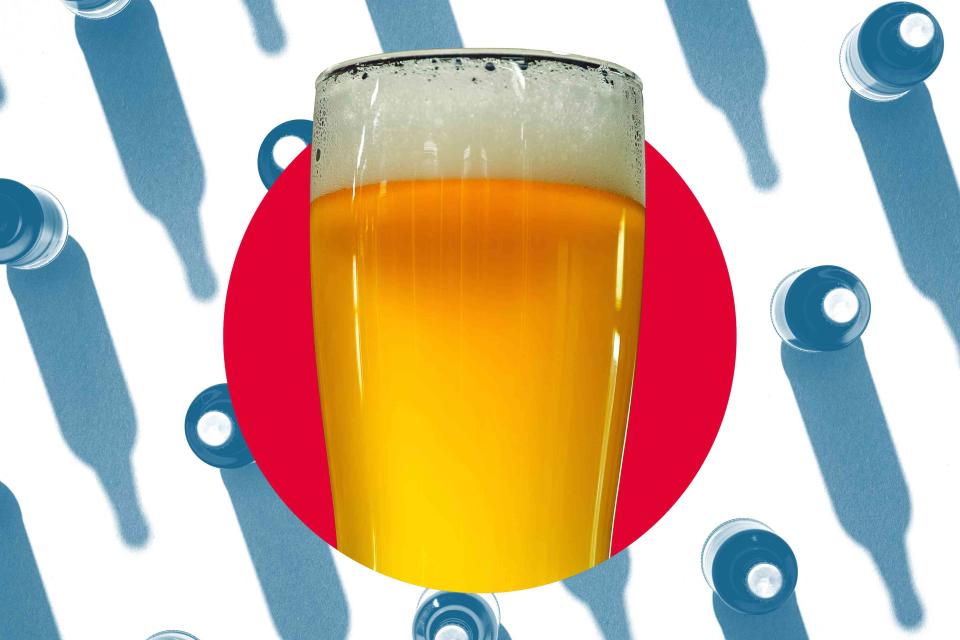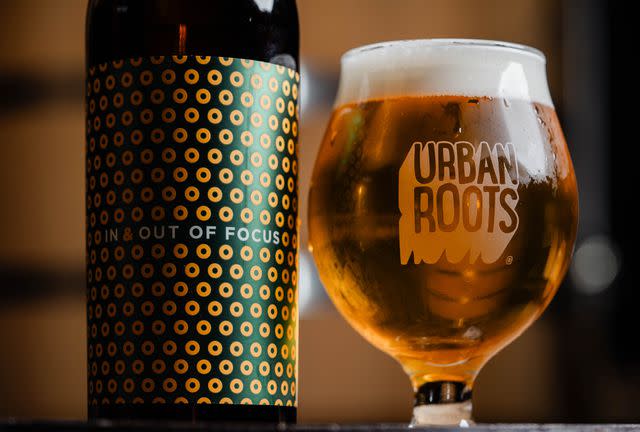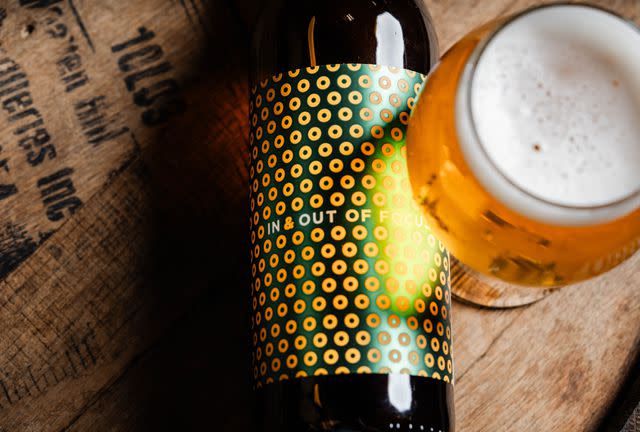Meet the Centuries-Old Belgian Beer Style That's a Warm-Weather Refresher
For beer drinkers in the know, May welcomes the most wonderful time of the year — saison season.

Food & Wine / Getty Images
While saison (the French word for “season”) is a delicious style of beer to enjoy year-round, its dryness, high carbonation, and balanced fruity flavors make it especially refreshing in warmer weather. As far back as the eighteenth century in Wallonia, the French-speaking region of Belgium, these beers were brewed in the winter and conditioned to be ready in time for rising temperatures in May, giving farm laborers something thirst-quenching and fortifying to drink.
But a saison is a true treat that’s gained popularity in recent years, with an array of styles being produced across the globe. Here’s what to know about this light, sessionable style of beer.
Related: Here’s the Real Reason Beer Comes in Aluminum Cans
What is a saison?
“Saison” refers to a small category of farmhouse ales that follow a generally dry, effervescent, fruity formula, with different interpretations. They often include rustic ingredients and fermentations that can include wild yeasts and varying levels of control.
“The saison style is great because it allows brewers to get creative with their recipes,” says Christa Sobier, owner of Brooklyn beer bar and bottle shop Beer Witch. The bar was recently one of many to host Saison Day, an event now in its 10th year that was founded by Allagash Brewing Company to celebration the style.
“Saisons can be hoppy, sour, or funky,” says Sobier. “History says it allowed farmworkers to use whatever ingredients they had on hand. [In addition to malted barley], the rest of the grist can include rye, wheat, [and] spelt. Spices and herbs are options but not required, Saisons can be pale or dark, and the ABV can range in strength from ‘table’ (sessionable), to ‘standard,’ to ‘super.’”
Fermentation plays a large role in defining saisons. Sobier explains that the traditional Wallonia saison is made with Belgian pale malt and French Belgian yeast, which yield a light grainy flavor offering some citrus, stone fruit, and pome fruit esters alongside white pepper phenols. Esters, which are typically fruity, and phenols, which are often spicy, refer to the flavor compound byproducts of the fermentation process.
“Saison flavors and aromatics tend to be largely driven by the type of yeast employed and the type of fermentation it undergoes,” says Ben Petersen, head brewer at Threes Brewing in Brooklyn, which offers seven saisons and farmhouse ales.
“At Threes, our saison fermentations are done with our house strain of saison yeast at particularly warm temperatures, 80–90°F, in comparison to the fermentations of many other ales, 65–71°F,” says Petersen. “This warmer fermentation creates the specific flavor profile saison is known for and emulates how saisons were originally brewed in [Belgian and French] farmhouses.”

Urban Roots
At Urban Roots Brewing in Sacramento, brand ambassador Sayre Piotrkowski emphasizes how decisions made regarding the fermentation process, as well as adding nontraditional ingredients like roses or lavender, allows brewers to get creative.
“The yeasts that are typically used to brew saison are among the most expressive in a brewer’s toolbox,” he says, adding that saison fermentation may happen in less controlled environments than needed for other styles. This means wild yeasts and bacteria may be introduced, like Brettanomyces, which can lend floral and earthy flavors as well as notes that are often described as “barnyard” or “funky.”
In addition to a variety of grains and yeast strains, producers can add different herbs, spices, and botanicals to their brews. Saisons also offer brewers latitude to play with the amount of hops used.
The style’s boosted level of carbonation is due to many saisons being bottle-conditioned. This means in addition to carbonation being created during fermentation, more bubbles come from a secondary fermentation in which a little yeast and sugar are added to the beer upon bottling.
What do saisons taste like?
Saisons can run a gamut in terms of flavor and aroma, but there are a few hallmark traits.
In addition to dryness, fruitiness, effervescence, and hoppiness, Petersen says a saison will have lower acidity relative to sour ales. “[This approaches levels that are similar to the natural acidity of some fruits, which does wonders for its drinkability and is something maybe wine drinkers can really get behind,” he says.
Considering this level of acidity and the saison’s dry finish, Petersen calls the style, “bright and spritzy, kinda’ like the Champagne…of beers?”
Petersen points out that brewers have many options for saison ingredients, and appreciate the style’s opportunity for connecting beer to the land. Threes sources their barley, wheat, and other grains like rye, buckwheat, and spelt locally whenever possible. “We find the local grains to be quite expressive and make delightful flavor contributions that can be perceived as spring honey, freshly baked bread, and even [spice] from grains like rye,” says Petersen.
Time is another ingredient, of sorts, according to Piotrkowski.
“Whether we are talking about a clean, fresh saison like our Tomorrow’s Verse or a beer that spends years in oak like our In and Out of Focus, we are fascinated by the relationship saisons can have with time,” he says. “Not just the length of time it takes to make a beer, but also how these beers, over the course of maturation in the brewery or aging after they are packaged, can taste brilliant one day and immature the next.”

Urban Roots
How to pair saisons with food
“Saisons are some of the most food-friendly beers,” says Cory King, founder of Maplewood, Missouri’s Side Project Brewing. King loves combining the style beer with mussels, preferably those that have been cooked in the saison.
King also recommends pairing saison with creamy, fatty cheeses, as the dryness and elevated carbonation help scrub the palate and the spicy, floral, fruity notes work especially well together.
Other fantastic saison pairings include seared scallops with spices, grilled vegetables, light meats like chicken, creamy mushroom pasta, and funky goat cheese. ”The high carbonation and spicy phenols make it a great beer to cut the fat in Indian foods, where the fruit and spice often complement a lot of the same spicy flavors, like ginger,” says Sobier.
“Saison and chevre is one of the most can’t-miss pairings I know of,” says Piotrkowski. “In the ideal scenario, both the beer and the cheese have a relationship to the local terroir, but even when that’s not the case, there are plenty of harmonies to be had. Tartness and fruity tang appear in both, as do grassiness, herbaceousness, and spice.”
Saisons to try
In today’s craft beer marketplace, saison remains relatively under-the-radar, and the brewers who make them tend to be specialists.
“On paper, a saison looks easy to brew,” says King. “However, because they are so light and dry, the most subtle flaw is amplified, making it challenging to do well. From the water to the fermentation, everything has to be perfect. Being that they are not brewed by every brewery, they remain niche and keep consumers from being exposed enough to get to that [mass] market awareness that drives demand for them from brewers.”
Petersen says that saisons tend to be overshadowed by IPAs and lagers, but both he and Piotrkowski see growth potential on the horizon. Piotrkowski points to parallels between the style and natural wine.
“I think the incredible enthusiasm we are witnessing for ‘natty wine’ reflects a desire for unfamiliar and unpredictable flavors and aromas,” he says. “Saison can certainly fill that niche.”
From floral and funky to crisp and hoppy, here are a few standout Saisons to know.
Saison Dupont: Brewed in Belgium since 1844, Saison Dupont is the best-known example of the style, and is the pick any beer pro will steer someone new to the category toward. It’s 6.5% ABV, with notes of grapefruit and cloves.
Boulevard Brewing Company Tank 7: Tank 7 is about as classic as saison gets within American craft beer. Kansas City’s Boulevard started making it in 2009. At 8.5% ABV, it packs a kick of citrus and spice.
Threes Brewing Wandering Bine: This saison from Threes utilizes the solera method, which blends different portions of the beer aged for different amounts of time for added complexity. Threes has been brewing Wandering Bine, 6.5% ABV, for eight years and is on Blend 18. Expect notes of green apple skin, mixed berries, and “fruity funk.”
Urban Roots Brewing In and Out of Focus: Released in time for Urban Roots to host saison Day 2024, this 7% ABV beer was brewed with spicy rye in its grain bill and foeder-aged for three years for complex, funky characteristics.
Side Project Saison du Fermier: Side Project brews this saison with local spelt, creating what they call a “Missouri saison” that they then age in oak. This beer anchors a Fermier series, in which Side Project releases different vintages and variations aged in different vessels each year.
For more Food & Wine news, make sure to sign up for our newsletter!
Read the original article on Food & Wine.


